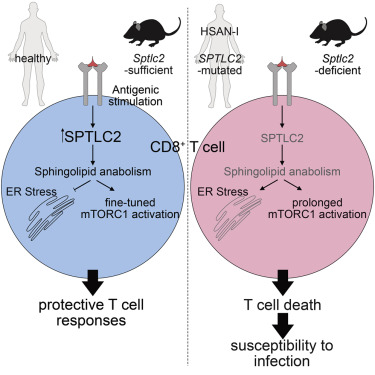Our official English website, www.x-mol.net, welcomes your
feedback! (Note: you will need to create a separate account there.)
Loss of Neurological Disease HSAN-I-Associated Gene SPTLC2 Impairs CD8+ T Cell Responses to Infection by Inhibiting T Cell Metabolic Fitness.
Immunity ( IF 25.5 ) Pub Date : 2019-04-02 , DOI: 10.1016/j.immuni.2019.03.005 Jingxia Wu 1 , Sicong Ma 2 , Roger Sandhoff 3 , Yanan Ming 4 , Agnes Hotz-Wagenblatt 5 , Vincent Timmerman 6 , Nathalie Bonello-Palot 7 , Beate Schlotter-Weigel 8 , Michaela Auer-Grumbach 9 , Pavel Seeman 10 , Wolfgang N Löscher 11 , Markus Reindl 11 , Florian Weiss 12 , Eric Mah 13 , Nina Weisshaar 14 , Alaa Madi 14 , Kerstin Mohr 1 , Tilo Schlimbach 1 , Rubí M-H Velasco Cárdenas 1 , Jonas Koeppel 1 , Florian Grünschläger 1 , Lisann Müller 1 , Maren Baumeister 1 , Britta Brügger 15 , Michael Schmitt 16 , Guido Wabnitz 17 , Yvonne Samstag 17 , Guoliang Cui 14
Immunity ( IF 25.5 ) Pub Date : 2019-04-02 , DOI: 10.1016/j.immuni.2019.03.005 Jingxia Wu 1 , Sicong Ma 2 , Roger Sandhoff 3 , Yanan Ming 4 , Agnes Hotz-Wagenblatt 5 , Vincent Timmerman 6 , Nathalie Bonello-Palot 7 , Beate Schlotter-Weigel 8 , Michaela Auer-Grumbach 9 , Pavel Seeman 10 , Wolfgang N Löscher 11 , Markus Reindl 11 , Florian Weiss 12 , Eric Mah 13 , Nina Weisshaar 14 , Alaa Madi 14 , Kerstin Mohr 1 , Tilo Schlimbach 1 , Rubí M-H Velasco Cárdenas 1 , Jonas Koeppel 1 , Florian Grünschläger 1 , Lisann Müller 1 , Maren Baumeister 1 , Britta Brügger 15 , Michael Schmitt 16 , Guido Wabnitz 17 , Yvonne Samstag 17 , Guoliang Cui 14
Affiliation

|
Patients with the neurological disorder HSAN-I suffer frequent infections, attributed to a lack of pain sensation and failure to seek care for minor injuries. Whether protective CD8+ T cells are affected in HSAN-I patients remains unknown. Here, we report that HSAN-I-associated mutations in serine palmitoyltransferase subunit SPTLC2 dampened human T cell responses. Antigen stimulation and inflammation induced SPTLC2 expression, and murine T-cell-specific ablation of Sptlc2 impaired antiviral-T-cell expansion and effector function. Sptlc2 deficiency reduced sphingolipid biosynthetic flux and led to prolonged activation of the mechanistic target of rapamycin complex 1 (mTORC1), endoplasmic reticulum (ER) stress, and CD8+ T cell death. Protective CD8+ T cell responses in HSAN-I patient PBMCs and Sptlc2-deficient mice were restored by supplementing with sphingolipids and pharmacologically inhibiting ER stress-induced cell death. Therefore, SPTLC2 underpins protective immunity by translating extracellular stimuli into intracellular anabolic signals and antagonizes ER stress to promote T cell metabolic fitness.
中文翻译:

神经疾病HSAN-1相关基因SPTLC2的丧失可通过抑制T细胞代谢适应性来削弱CD8 + T细胞对感染的反应。
神经系统疾病HSAN-I的患者经常感染,这归因于缺乏疼痛感和无法为轻伤寻求护理。HSAN-I患者中保护性CD8 + T细胞是否受到影响尚不清楚。在这里,我们报道丝氨酸棕榈酰转移酶亚基SPTLC2的HSAN I相关突变抑制了人类T细胞反应。抗原刺激和炎症诱导SPTLC2表达,Sptlc2的小鼠T细胞特异性消融损害了抗病毒T细胞的扩增和效应子功能。Sptlc2缺乏症降低了鞘脂的生物合成通量,并导致雷帕霉素复合物1(mTORC1)的机械靶标,内质网(ER)应激和CD8 + T细胞死亡的激活时间延长。通过补充鞘脂并药理抑制ER应激诱导的细胞死亡,可以恢复HSAN-1患者PBMC和Sptlc2缺陷型小鼠中的保护性CD8 + T细胞应答。因此,SPTLC2通过将细胞外刺激转化为细胞内合成代谢信号来增强保护性免疫,并拮抗内质网应激,从而促进T细胞代谢适应性。
更新日期:2019-04-02
中文翻译:

神经疾病HSAN-1相关基因SPTLC2的丧失可通过抑制T细胞代谢适应性来削弱CD8 + T细胞对感染的反应。
神经系统疾病HSAN-I的患者经常感染,这归因于缺乏疼痛感和无法为轻伤寻求护理。HSAN-I患者中保护性CD8 + T细胞是否受到影响尚不清楚。在这里,我们报道丝氨酸棕榈酰转移酶亚基SPTLC2的HSAN I相关突变抑制了人类T细胞反应。抗原刺激和炎症诱导SPTLC2表达,Sptlc2的小鼠T细胞特异性消融损害了抗病毒T细胞的扩增和效应子功能。Sptlc2缺乏症降低了鞘脂的生物合成通量,并导致雷帕霉素复合物1(mTORC1)的机械靶标,内质网(ER)应激和CD8 + T细胞死亡的激活时间延长。通过补充鞘脂并药理抑制ER应激诱导的细胞死亡,可以恢复HSAN-1患者PBMC和Sptlc2缺陷型小鼠中的保护性CD8 + T细胞应答。因此,SPTLC2通过将细胞外刺激转化为细胞内合成代谢信号来增强保护性免疫,并拮抗内质网应激,从而促进T细胞代谢适应性。











































 京公网安备 11010802027423号
京公网安备 11010802027423号